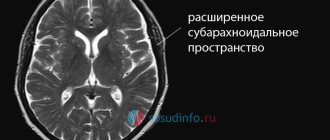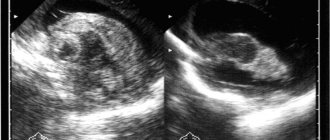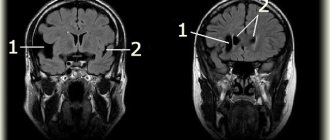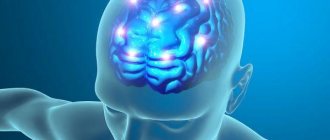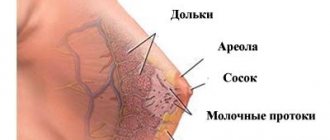© Author: A. Olesya Valerievna, candidate of medical sciences, practicing physician, teacher at a medical university, especially for SosudInfo.ru (about the authors)
Hypertension syndrome (HS) is quite common in the diagnoses of neurologists; it affects both adults and children. Increased intracranial pressure is almost always a symptom of a serious illness, so it cannot be ignored. At the same time, in pediatric practice there are often cases of overdiagnosis of this condition, and with a detailed examination in more than 90% of children with a “mild form” it is not confirmed.
The cranial cavity is limited by bones and has a constant volume, so an increase in its contents is always accompanied by clinical symptoms. An increase in intracranial pressure accompanies neoplasms, the appearance of excess fluid, hematoma, head trauma ; it can be acute or chronic, but always requires the close attention of specialists.
If in adults everything is more or less clear with intracranial hypertension (ICH), then in children the issues of correct diagnosis and treatment have not yet been completely resolved. The fact is that in a baby, the pressure in the skull often increases with prolonged and strong crying or screaming; this can be considered a variant of the norm in the absence of other reasons. Such transient hypertension does not always manifest itself clinically, because the skull bones in babies have not yet completely fused; there are fontanelles, which makes it possible to “smooth out” the manifestations of ICH.
It happens that a preliminary diagnosis is given to a child only on the basis that his head is relatively large, and the baby is restless and often cries, but studies show that there is no clear relationship between a large head size and hypertension syndrome. For these reasons, it is worth carefully examining the baby and being very careful about the conclusions about the presence of a pathological nature of ICP and, even more so, about prescribing treatment.
Causes and types of hypertension syndrome
The reasons for the increase in pressure inside the skull are usually the appearance of some additional tissue or volume of fluid in it, which does not fit into the available space and compresses the brain. Among the most likely factors for the development of HS are:
- Tumors.
- Hemorrhages into the brain tissue or under the membranes.
- Poor circulation of cerebrospinal fluid.
- Injuries.
- Neuroinfections and inflammatory processes (meningitis, encephalitis).
- Discirculatory encephalopathy.
- Pathological course of pregnancy and childbirth (intrauterine hypoxia and fetal infections, rapid, premature or late birth, injuries during passage through the birth canal, etc.).
Hypertension syndrome can be acute or chronic. In the first case, there is a rapid increase in pressure in the cranial cavity and an increase in symptoms of brain damage, coma and displacement of brain structures are possible. Chronic ICH is characterized by a gradual increase in pressure, which usually does not reach maximum and life-threatening numbers.
the occurrence of HS due to a hematoma (or formation) in the cranial cavity
A large group of causes of ICH are various types of formations, which lead to pathology mainly in adults. These include both malignant and benign tumors, metastases, cysts, hematomas, brain abscesses, vascular malformations and large aneurysms. All these processes create additional volume in the skull, the contents of which begin to fit poorly, resulting in increased pressure and compression of the brain.
ICH often appears when the size of the brain increases due to its swelling, which accompanies strokes, inflammatory processes, bruises, toxic lesions due to liver pathology, poisoning, and severe hypoxia. The enlarged brain takes up more and more space, and pressure in the skull increases.
Circulatory disorders in the vessels of the brain can also contribute to HS. Thus, difficulty in venous outflow due to dyscirculatory encephalopathy, abnormalities of the vascular bed, defects in the bone structures of the spine leads to the accumulation of venous blood in the cerebral sinuses, which contributes to a chronic, gradual increase in pressure in the skull.
Hypertension syndrome in children often occurs due to pathology of cerebrospinal fluid dynamics, which may consist of excessive formation of cerebrospinal fluid, disruption of its excretion or circulation through the intershell spaces and ventricles. The cerebrospinal fluid creates additional volume, which even the pliable bones in infants are unable to compensate for, and ICH develops, which is called cerebrospinal fluid hypertension syndrome.
Liquorodynamic disorders are accompanied by the accumulation of excess fluid in the cavities - the ventricles of the brain. The latter expand, pushing brain tissue to the periphery, which can lead to atrophy of the hemispheres. Such forms of ICH are called hypertensive-hydrocephalic syndrome, thereby indicating the presence of both ICH and hydrocephalus. In the clinic, both symptoms of hydrocephalus and intracranial hypertension may predominate.
In newborn babies, an increase in pressure inside the skull is facilitated by birth injuries and pathology during labor, prolonged hypoxia, intrauterine infection with cytomegalovirus, toxoplasma and other pathogens. Against this background, even before birth, cysts, developmental defects and anomalies can form in the child’s brain, preventing the normal flow of cerebrospinal fluid. Such children can be diagnosed already in the maternity hospital.
Regardless of the causes, the consequence of intracranial hypertension is always a dysfunction of neurons due to compression of the brain, inadequate oxygen supply, and ischemic damage, therefore the manifestations of ICH are usually stereotypical.
Treatment methods for hydrocephalus
The surgical method of treating hydrocephalus is used only in extreme cases (decompensated forms of internal hydrocephalus), excess fluid is drained from the cranial cavity into the abdominal cavity using a tube (shunt), this operation, like any other, is quite traumatic; in the future, several more surgical operations may be required interventions to replace and check the operation of the shunt.
A medicinal method of treating hydrocephalus - the use of diuretics, such as Diacarb, is often used by neurologists in outpatient practice. Diakarb removes fluid not only from the cranial cavity, but also from the body as a whole, at the same time a loss of microelements occurs, the effect of this treatment method is temporary, after its cessation, the fluid begins to accumulate again and intracranial pressure increases.
Herbal medicine - the use of diuretic herbs (horsetail, fennel, lingonberry leaf), does not cause addiction and loss of microelements. It is used, as a rule, for preventive purposes: to avoid exacerbation of hydrocephalus during colds, when changing climatic zones, in the autumn-spring period with pronounced changes in weather conditions.
Massage is an effective method for children with motor impairments (increased muscle tone, delayed motor development), and is mainly aimed at relaxing tense muscles. It is advisable to use only in complex treatment, since massage does not affect the main cause of the disease - hydrocephalus and hypoxia of the cerebral cortex.
MICROCURRENT REFLEXOTHERAPY - the method is effective in children with various manifestations of hydrocephalus, it allows you to eliminate not only external manifestations (hysterics, developmental delays, etc.), but also treat hydrocephalus itself, that is, it has a complex therapeutic effect on the body. The effect of treatment is stable and does not stop after the end of treatment.
Signs of increased pressure in the skull
If you have symptoms suspicious of an increase in intracranial pressure, you need to correctly evaluate all the existing signs, especially in young children, because correct diagnosis is the key to effective treatment.
Hypertension syndrome is accompanied by:
- Headache;
- Nausea and vomiting;
- Depression of consciousness of varying degrees (acute forms);
- Anxiety, irritability and sleep disorders;
- Meteosensitivity;
- Visual impairment;
- Developmental delay in children and cognitive decline in adults.
The most important symptom reported by most patients is headache. It can be sudden, pulsating, abruptly occurring in acute ICH, or gradually increasing in the chronic course of the pathology. Usually there is symmetry of the lesion and localization of pain in the frontal and parietal regions. Adult patients describe it as “bursting”, as if coming from inside the head. Cranialgia is more typical in the morning hours or when the patient takes a horizontal position, since in this case the circulation of cerebrospinal fluid is difficult.
With significant levels of intracranial pressure, cranialgia is accompanied by a feeling of lightheadedness, nausea and even vomiting, depression of consciousness up to coma, and cardiac arrhythmias (bradycardia or tachycardia) are possible. Sometimes ICH leads to seizures.
Many patients complain of autonomic disorders in the form of dizziness, sweating, fluctuations in body temperature and blood pressure, and fainting. These symptoms, coupled with cranialgia, often become a reason to seek help.
Adult patients note impairment of both physical and mental performance, decreased memory and concentration, and the appearance of irritability and emotional instability. Pain in the eyeballs and decreased visual acuity are possible. Both children and adults with ICH are very sensitive to weather conditions, and any change in the weather can cause an increase in symptoms.
In children, diagnosis can be difficult due to the fact that young patients cannot always describe their complaints, and infants are not at all able to speak. The presence of hypertension syndrome in infants and young children is indicated by:
- Severe anxiety and prolonged crying;
- Sleep disturbances, frequent awakenings, difficulty falling asleep;
- Breast refusal;
- Regurgitation, often in a “fountain”.
The children's brain is very sensitive to trophic disturbances, so long-term ICH is usually accompanied by delayed mental and physical development. The baby is developmentally delayed, motor skills, speech, and thinking suffer. The child does not sit up in due time, does not learn to walk or speak, and is not capable of learning.
Young parents are often frightened by the prospect of developmental disorders in their infant, who is suspected of having increased intracranial pressure. It is worth noting that in many cases, proper treatment helps eliminate the symptoms of brain pathology and restore its proper functioning. Even existing signs of delayed psycho-speech development can be eliminated through therapy and sessions with a specialist.
With hypertensive-hydrocephalic syndrome in children, a predominance of one or another of its manifestations may be noted. So, with pronounced hypertension, the baby is restless, cries, sleeps poorly, and with moderate hypertension, but severe hydrocephalus, on the contrary, there is a tendency to lethargy, lethargy, and low activity of the child.
External signs of HS do not always occur. With significant levels of intracranial pressure in adults, dark circles may appear under the eyes, which are not associated with sleep and rest patterns, and upon careful examination, small subcutaneous veins can be seen. In young children, when the final formation of sutures between the bones of the skull has not yet occurred, long-term ICH against the background of hydrocephalus causes more pronounced external changes: the head becomes very large, venous vessels appear in the skin.
How to treat hypertension-cerebrospinal fluid syndrome in children
When treating hypertensive-hydrocephalic syndrome in children, it is mandatory to take medications that help remove accumulated cerebrospinal fluid. To eliminate the symptoms of pathology, drugs that stabilize the tone of the muscular system are also needed. Soothing herbal decoctions in combination with sedatives help to finally normalize the condition of the little patient. Recovery will be faster if you provide your child with the correct daily routine and nutrition. Daily walks in the fresh air are very important.
Diagnosis and treatment of hypertension syndrome
Correct diagnosis of HS still poses great difficulties. Doctors do not have a consensus on what pressure fluctuations should be considered the normal limit, especially in children in the absence of a causative factor for ICH. Reliable methods for determining cerebrospinal fluid pressure are particularly difficult. Most diagnostic procedures provide indicative information based on indirect signs of pathology, and ICH can be accurately determined only by invasive and complex methods available to neurosurgical hospitals.
If there are symptoms of hypertension syndrome, echoencephalography, examination by an ophthalmologist, and radiography of the skull are indicated. Ophthalmoscopy shows papilledema and vascular changes, which may indirectly indicate ICH. X-rays of the skull bones can reveal changes in the shape of the bones, their deformation, and “finger impressions.”
dilation of the cerebral ventricles in hydrocephalic HS
To find the cause of hypertension syndrome, ultrasound techniques, computed tomography and magnetic resonance imaging, and angiography are used if aneurysms or vascular malformations are suspected.
The most reliable and, at the same time, the most radical way to diagnose hypertension syndrome is a lumbar puncture with measurement of cerebrospinal fluid pressure. In some cases, they resort to puncture of the cerebral ventricles, but this requires craniotomy. Whenever possible, doctors try to avoid dangerous invasive procedures, examining the patient as much as possible using safer methods.
Treatment of intracranial hypertension is the prerogative of neurologists. Efficiency largely depends on the quality of diagnosis and the doctor’s literacy. There are still frequent cases when it is prescribed unreasonably, especially in pediatric practice, so it is important for parents to consult a specialist who can be trusted with the health of the child.
Conservative therapy is usually carried out at home, in cases of chronic ICH, and is aimed at improving the outflow of fluid from the cranial cavity. In case of acute onset of pathology, a conservative approach is indicated if there is no sharp increase in intracranial pressure and there is no threat of displacement of brain structures.
The main group of drugs for reducing intracranial pressure are diuretics. Diacarb, veroshpiron, hypothiazide are prescribed. Pediatricians usually use Diacarb. In severe cases, mannitol is administered intravenously.
In addition to diuretics, drugs are used to treat the underlying disease:
- Antibiotics and antivirals for infections;
- Vascular drugs (Cavinton, cinnarizine) and venotonics (Detralex) for cerebral circulatory disorders;
- Antitumor therapy in case of neoplasms.
To level out the symptoms of compression of brain tissue, drugs that improve the metabolism of neurons are indicated - Fezam, Cerebrolysin, Sermion, etc. Children, in addition to medications, need corrective classes if ICH causes developmental delay.
In addition to medical prescriptions, the patient should avoid physical and emotional stress, avoid working at the computer, watching TV and listening to music, and reading, since eye strain can provoke an increase in the symptoms of hypertension syndrome.
In mild cases, small doses of diuretics are prescribed; it is recommended to establish a regimen and limit drinking. The effect of special exercises, massage, manual therapy is possible.
In acute HS with a risk of displacement of brain structures and coma, surgical treatment is indicated. It may consist of decompression trephination, when an additional hole is created in the bones, allowing the pressure in the skull to be reduced to acceptable levels, or ventricular puncture, indicated for hydrocephalic syndrome, is performed.
If the cause of the pathology is a tumor, cyst, or aneurysm, then surgery may involve removing them to eliminate the source of ICH. In case of congenital vascular pathology (aneurysm of the vein of Galen, for example), shunt operations are performed to allow the discharge of “excess” venous blood from the vessels of the brain.
Children who have been diagnosed with hypertension syndrome must be constantly in the field of view of neurologists and undergo examinations and monitoring of the course of the pathology at least 2 times a year. The task of parents is to ensure the correct regime, protect against infections and overload, and take them to the doctor for a consultation on time.
Impaired brain function in the form of cognitive disorders, autonomic symptoms and decreased ability to work significantly worsen the quality of life of patients with the chronic form of hypertension syndrome. In children, this pathology, in the absence of adequate measures, can lead to a sharp lag in development up to imbecility. Given the dangerous consequences, intracranial hypertension requires close attention from neurologists and timely treatment.
The prognosis for hypertension syndrome depends on the severity, speed of development of the pathology, and the root cause. It is clear that if a child has serious malformations of the nervous system or cerebral vessels, then it is not always possible to expect a complete recovery. In cases of moderate ICH, conservative treatment can completely eliminate the symptoms of the pathology and restore ability to work in adults and mental development in children. If you suspect intracranial hypertension or have symptoms of pathology, it is important not to wait for spontaneous recovery, but to get to a competent specialist in time.
Causes
The main cause of increased intracranial pressure syndrome is stagnation of cerebrospinal fluid. This condition may be a consequence of the following diseases and cases:
- traumatic brain injuries;
- cerebral edema;
- hydrocephalus;
- prolonged oxygen starvation - hypoxia;
- violation of the outflow of venous blood;
- infections of the brain or its membranes;
- cerebral hemorrhages;
- malignant tumors in the brain;
- encephalitis;
- vascular hypotonicity;
- heredity.
Congenital
Due to congenital causes, hypertensive-hydrocephalic syndrome is more often observed in newborns. This pathology manifests itself in them due to:
- complications during pregnancy or childbirth;
- brain hypoxia;
- prematurity;
- subarachnoid hemorrhages;
- intrauterine infections;
- congenital brain defects;
- anhydrous period of more than 12 hours.
Purchased
Acquired causes are inherent in hypertensive-hydrocephalic syndrome, which develops in older children and adults. Their list includes:
- the presence of foreign bodies in the brain;
- infectious diseases;
- stroke and its consequences;
- endocrinological diseases;
- brain tumors, hematomas, abscesses, cysts in the brain;
- traumatic brain injuries;
- spontaneous increase in pressure.
